Burn Injuries: Etiology, Types, Comorbidities, Wound Products Analysis
VerifiedAdded on 2022/09/07
|9
|2451
|17
Report
AI Summary
This report provides a comprehensive analysis of burn injuries, addressing their etiology, types, and associated comorbidities. It explores various classifications of burns based on their causes and severity, including thermal, chemical, and electrical burns, and their impact on individuals. The report delves into the common comorbidities associated with severe burns, such as infections, respiratory issues, and organ failure. Furthermore, it examines various wound care products and their efficacy in burn wound management, including Silver sulfadiazine cream, Dressilk, and Biobrane. The report also discusses the impact of burn injuries on individuals, including pain, anxiety, and financial burdens, as well as the significance of nursing care in the recovery process. The conclusion emphasizes the importance of understanding burn injuries for healthcare professionals, particularly nurses, to provide optimal patient care and support.

Running head: BURNS
BURNS
Name of the student:
Name of the university:
Author note
BURNS
Name of the student:
Name of the university:
Author note
Paraphrase This Document
Need a fresh take? Get an instant paraphrase of this document with our AI Paraphraser
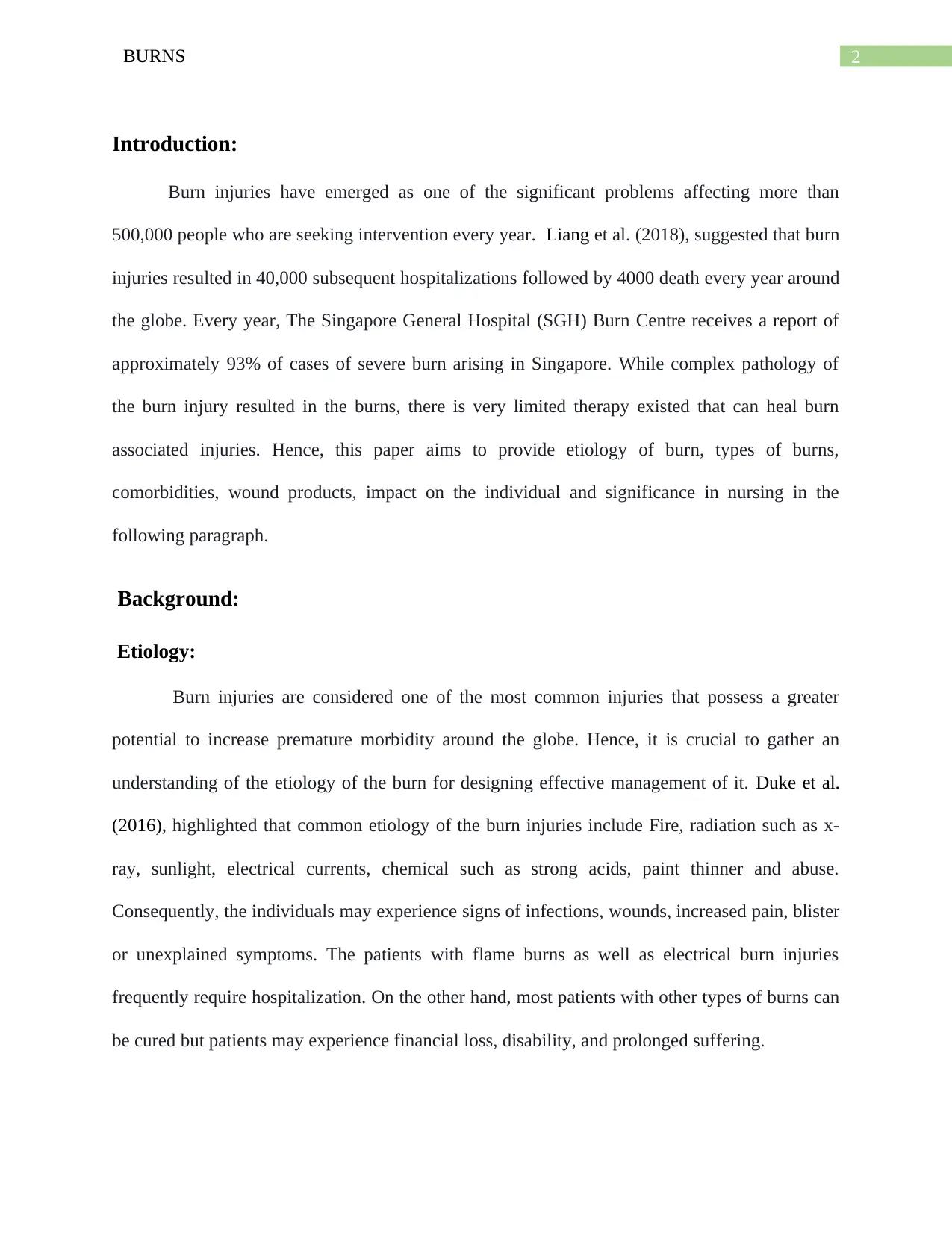
2BURNS
Introduction:
Burn injuries have emerged as one of the significant problems affecting more than
500,000 people who are seeking intervention every year. Liang et al. (2018), suggested that burn
injuries resulted in 40,000 subsequent hospitalizations followed by 4000 death every year around
the globe. Every year, The Singapore General Hospital (SGH) Burn Centre receives a report of
approximately 93% of cases of severe burn arising in Singapore. While complex pathology of
the burn injury resulted in the burns, there is very limited therapy existed that can heal burn
associated injuries. Hence, this paper aims to provide etiology of burn, types of burns,
comorbidities, wound products, impact on the individual and significance in nursing in the
following paragraph.
Background:
Etiology:
Burn injuries are considered one of the most common injuries that possess a greater
potential to increase premature morbidity around the globe. Hence, it is crucial to gather an
understanding of the etiology of the burn for designing effective management of it. Duke et al.
(2016), highlighted that common etiology of the burn injuries include Fire, radiation such as x-
ray, sunlight, electrical currents, chemical such as strong acids, paint thinner and abuse.
Consequently, the individuals may experience signs of infections, wounds, increased pain, blister
or unexplained symptoms. The patients with flame burns as well as electrical burn injuries
frequently require hospitalization. On the other hand, most patients with other types of burns can
be cured but patients may experience financial loss, disability, and prolonged suffering.
Introduction:
Burn injuries have emerged as one of the significant problems affecting more than
500,000 people who are seeking intervention every year. Liang et al. (2018), suggested that burn
injuries resulted in 40,000 subsequent hospitalizations followed by 4000 death every year around
the globe. Every year, The Singapore General Hospital (SGH) Burn Centre receives a report of
approximately 93% of cases of severe burn arising in Singapore. While complex pathology of
the burn injury resulted in the burns, there is very limited therapy existed that can heal burn
associated injuries. Hence, this paper aims to provide etiology of burn, types of burns,
comorbidities, wound products, impact on the individual and significance in nursing in the
following paragraph.
Background:
Etiology:
Burn injuries are considered one of the most common injuries that possess a greater
potential to increase premature morbidity around the globe. Hence, it is crucial to gather an
understanding of the etiology of the burn for designing effective management of it. Duke et al.
(2016), highlighted that common etiology of the burn injuries include Fire, radiation such as x-
ray, sunlight, electrical currents, chemical such as strong acids, paint thinner and abuse.
Consequently, the individuals may experience signs of infections, wounds, increased pain, blister
or unexplained symptoms. The patients with flame burns as well as electrical burn injuries
frequently require hospitalization. On the other hand, most patients with other types of burns can
be cured but patients may experience financial loss, disability, and prolonged suffering.
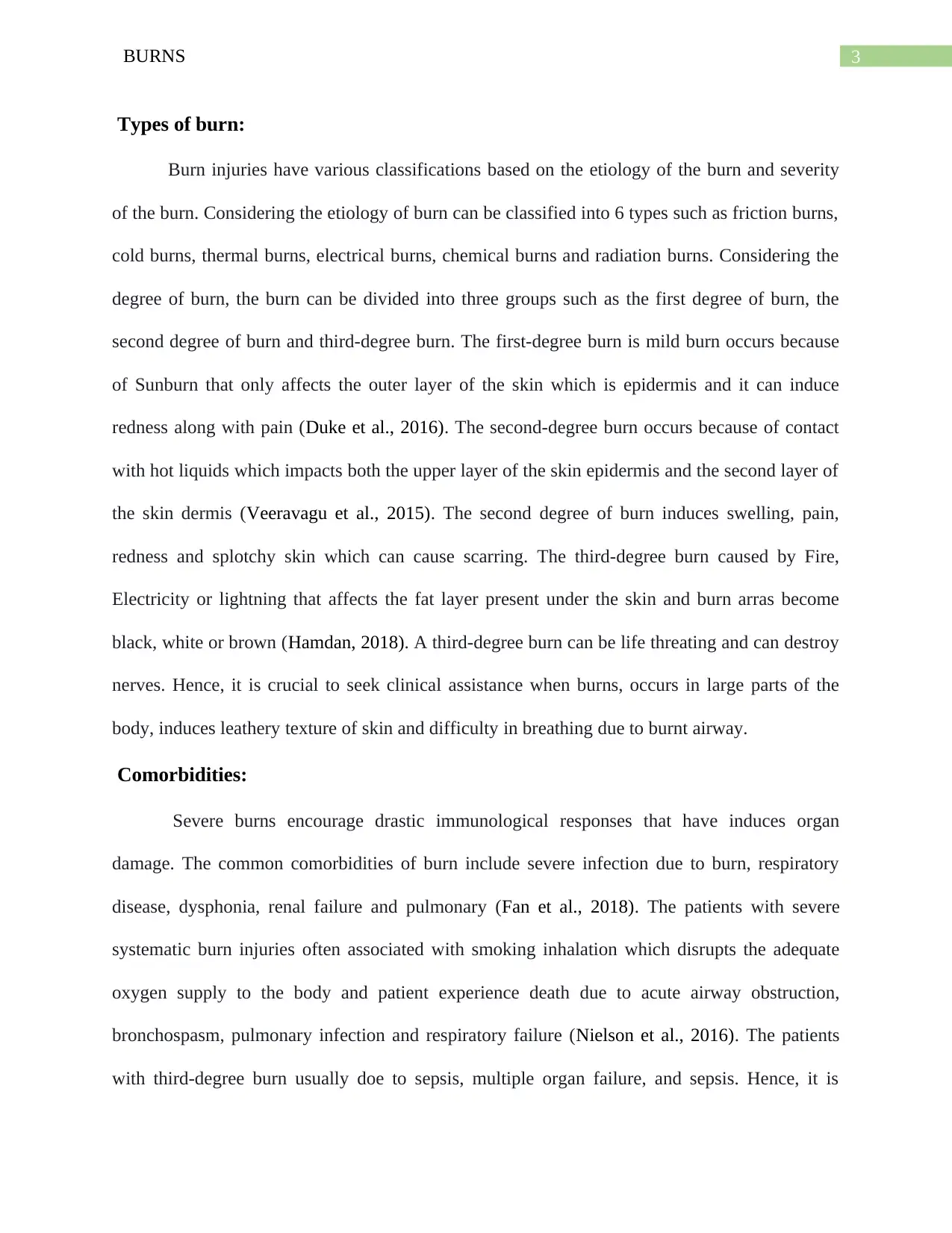
3BURNS
Types of burn:
Burn injuries have various classifications based on the etiology of the burn and severity
of the burn. Considering the etiology of burn can be classified into 6 types such as friction burns,
cold burns, thermal burns, electrical burns, chemical burns and radiation burns. Considering the
degree of burn, the burn can be divided into three groups such as the first degree of burn, the
second degree of burn and third-degree burn. The first-degree burn is mild burn occurs because
of Sunburn that only affects the outer layer of the skin which is epidermis and it can induce
redness along with pain (Duke et al., 2016). The second-degree burn occurs because of contact
with hot liquids which impacts both the upper layer of the skin epidermis and the second layer of
the skin dermis (Veeravagu et al., 2015). The second degree of burn induces swelling, pain,
redness and splotchy skin which can cause scarring. The third-degree burn caused by Fire,
Electricity or lightning that affects the fat layer present under the skin and burn arras become
black, white or brown (Hamdan, 2018). A third-degree burn can be life threating and can destroy
nerves. Hence, it is crucial to seek clinical assistance when burns, occurs in large parts of the
body, induces leathery texture of skin and difficulty in breathing due to burnt airway.
Comorbidities:
Severe burns encourage drastic immunological responses that have induces organ
damage. The common comorbidities of burn include severe infection due to burn, respiratory
disease, dysphonia, renal failure and pulmonary (Fan et al., 2018). The patients with severe
systematic burn injuries often associated with smoking inhalation which disrupts the adequate
oxygen supply to the body and patient experience death due to acute airway obstruction,
bronchospasm, pulmonary infection and respiratory failure (Nielson et al., 2016). The patients
with third-degree burn usually doe to sepsis, multiple organ failure, and sepsis. Hence, it is
Types of burn:
Burn injuries have various classifications based on the etiology of the burn and severity
of the burn. Considering the etiology of burn can be classified into 6 types such as friction burns,
cold burns, thermal burns, electrical burns, chemical burns and radiation burns. Considering the
degree of burn, the burn can be divided into three groups such as the first degree of burn, the
second degree of burn and third-degree burn. The first-degree burn is mild burn occurs because
of Sunburn that only affects the outer layer of the skin which is epidermis and it can induce
redness along with pain (Duke et al., 2016). The second-degree burn occurs because of contact
with hot liquids which impacts both the upper layer of the skin epidermis and the second layer of
the skin dermis (Veeravagu et al., 2015). The second degree of burn induces swelling, pain,
redness and splotchy skin which can cause scarring. The third-degree burn caused by Fire,
Electricity or lightning that affects the fat layer present under the skin and burn arras become
black, white or brown (Hamdan, 2018). A third-degree burn can be life threating and can destroy
nerves. Hence, it is crucial to seek clinical assistance when burns, occurs in large parts of the
body, induces leathery texture of skin and difficulty in breathing due to burnt airway.
Comorbidities:
Severe burns encourage drastic immunological responses that have induces organ
damage. The common comorbidities of burn include severe infection due to burn, respiratory
disease, dysphonia, renal failure and pulmonary (Fan et al., 2018). The patients with severe
systematic burn injuries often associated with smoking inhalation which disrupts the adequate
oxygen supply to the body and patient experience death due to acute airway obstruction,
bronchospasm, pulmonary infection and respiratory failure (Nielson et al., 2016). The patients
with third-degree burn usually doe to sepsis, multiple organ failure, and sepsis. Hence, it is
⊘ This is a preview!⊘
Do you want full access?
Subscribe today to unlock all pages.

Trusted by 1+ million students worldwide
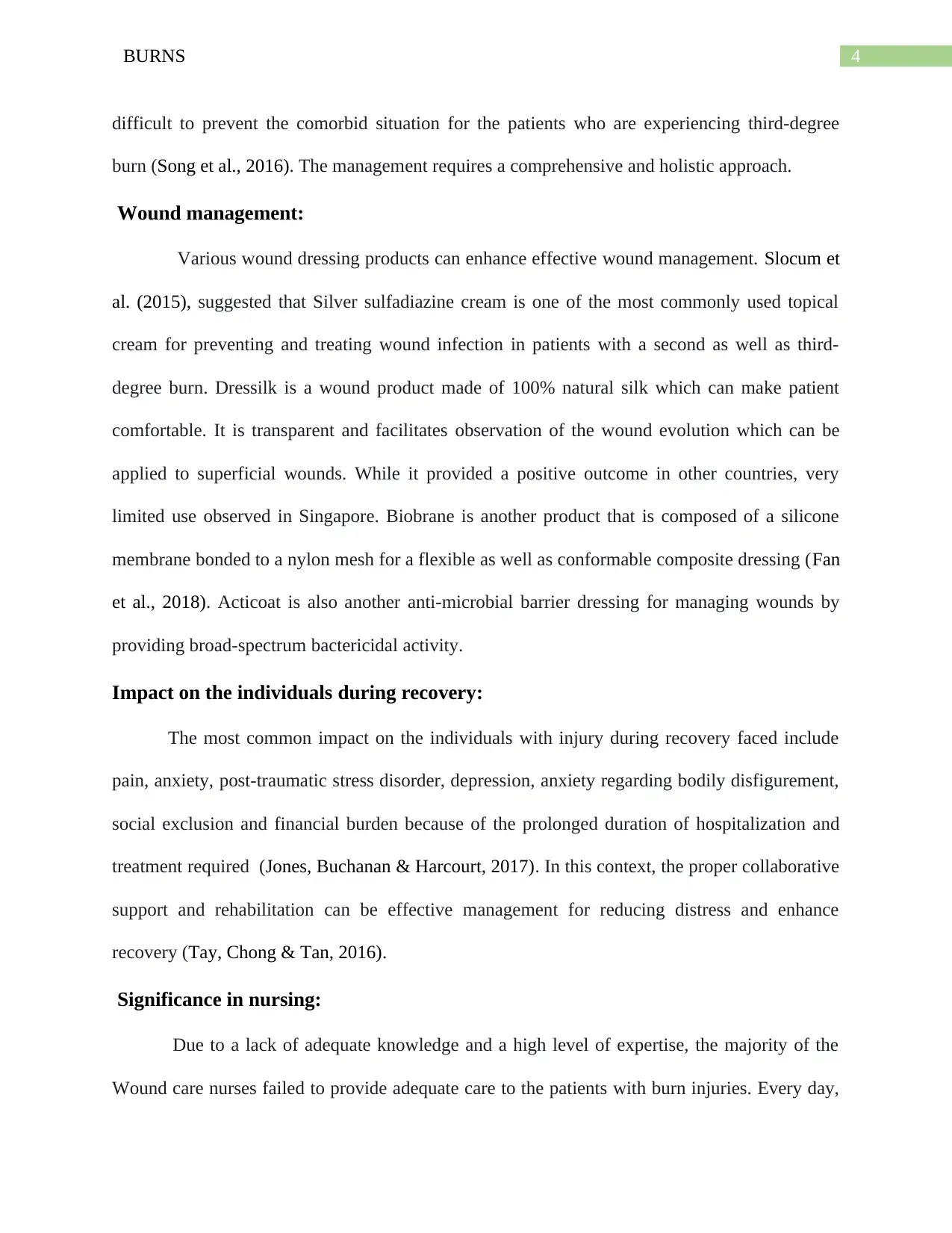
4BURNS
difficult to prevent the comorbid situation for the patients who are experiencing third-degree
burn (Song et al., 2016). The management requires a comprehensive and holistic approach.
Wound management:
Various wound dressing products can enhance effective wound management. Slocum et
al. (2015), suggested that Silver sulfadiazine cream is one of the most commonly used topical
cream for preventing and treating wound infection in patients with a second as well as third-
degree burn. Dressilk is a wound product made of 100% natural silk which can make patient
comfortable. It is transparent and facilitates observation of the wound evolution which can be
applied to superficial wounds. While it provided a positive outcome in other countries, very
limited use observed in Singapore. Biobrane is another product that is composed of a silicone
membrane bonded to a nylon mesh for a flexible as well as conformable composite dressing (Fan
et al., 2018). Acticoat is also another anti-microbial barrier dressing for managing wounds by
providing broad-spectrum bactericidal activity.
Impact on the individuals during recovery:
The most common impact on the individuals with injury during recovery faced include
pain, anxiety, post-traumatic stress disorder, depression, anxiety regarding bodily disfigurement,
social exclusion and financial burden because of the prolonged duration of hospitalization and
treatment required (Jones, Buchanan & Harcourt, 2017). In this context, the proper collaborative
support and rehabilitation can be effective management for reducing distress and enhance
recovery (Tay, Chong & Tan, 2016).
Significance in nursing:
Due to a lack of adequate knowledge and a high level of expertise, the majority of the
Wound care nurses failed to provide adequate care to the patients with burn injuries. Every day,
difficult to prevent the comorbid situation for the patients who are experiencing third-degree
burn (Song et al., 2016). The management requires a comprehensive and holistic approach.
Wound management:
Various wound dressing products can enhance effective wound management. Slocum et
al. (2015), suggested that Silver sulfadiazine cream is one of the most commonly used topical
cream for preventing and treating wound infection in patients with a second as well as third-
degree burn. Dressilk is a wound product made of 100% natural silk which can make patient
comfortable. It is transparent and facilitates observation of the wound evolution which can be
applied to superficial wounds. While it provided a positive outcome in other countries, very
limited use observed in Singapore. Biobrane is another product that is composed of a silicone
membrane bonded to a nylon mesh for a flexible as well as conformable composite dressing (Fan
et al., 2018). Acticoat is also another anti-microbial barrier dressing for managing wounds by
providing broad-spectrum bactericidal activity.
Impact on the individuals during recovery:
The most common impact on the individuals with injury during recovery faced include
pain, anxiety, post-traumatic stress disorder, depression, anxiety regarding bodily disfigurement,
social exclusion and financial burden because of the prolonged duration of hospitalization and
treatment required (Jones, Buchanan & Harcourt, 2017). In this context, the proper collaborative
support and rehabilitation can be effective management for reducing distress and enhance
recovery (Tay, Chong & Tan, 2016).
Significance in nursing:
Due to a lack of adequate knowledge and a high level of expertise, the majority of the
Wound care nurses failed to provide adequate care to the patients with burn injuries. Every day,
Paraphrase This Document
Need a fresh take? Get an instant paraphrase of this document with our AI Paraphraser
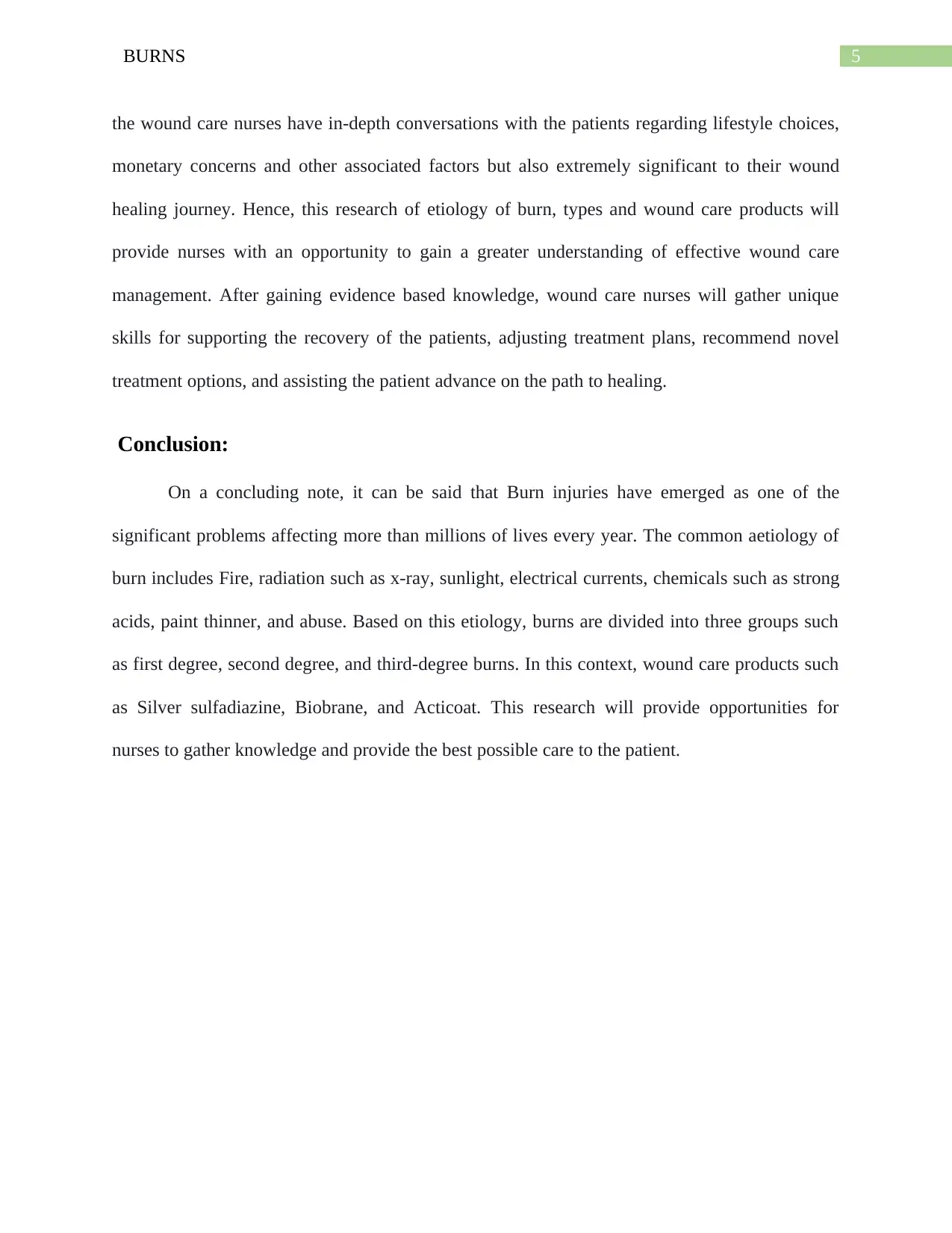
5BURNS
the wound care nurses have in-depth conversations with the patients regarding lifestyle choices,
monetary concerns and other associated factors but also extremely significant to their wound
healing journey. Hence, this research of etiology of burn, types and wound care products will
provide nurses with an opportunity to gain a greater understanding of effective wound care
management. After gaining evidence based knowledge, wound care nurses will gather unique
skills for supporting the recovery of the patients, adjusting treatment plans, recommend novel
treatment options, and assisting the patient advance on the path to healing.
Conclusion:
On a concluding note, it can be said that Burn injuries have emerged as one of the
significant problems affecting more than millions of lives every year. The common aetiology of
burn includes Fire, radiation such as x-ray, sunlight, electrical currents, chemicals such as strong
acids, paint thinner, and abuse. Based on this etiology, burns are divided into three groups such
as first degree, second degree, and third-degree burns. In this context, wound care products such
as Silver sulfadiazine, Biobrane, and Acticoat. This research will provide opportunities for
nurses to gather knowledge and provide the best possible care to the patient.
the wound care nurses have in-depth conversations with the patients regarding lifestyle choices,
monetary concerns and other associated factors but also extremely significant to their wound
healing journey. Hence, this research of etiology of burn, types and wound care products will
provide nurses with an opportunity to gain a greater understanding of effective wound care
management. After gaining evidence based knowledge, wound care nurses will gather unique
skills for supporting the recovery of the patients, adjusting treatment plans, recommend novel
treatment options, and assisting the patient advance on the path to healing.
Conclusion:
On a concluding note, it can be said that Burn injuries have emerged as one of the
significant problems affecting more than millions of lives every year. The common aetiology of
burn includes Fire, radiation such as x-ray, sunlight, electrical currents, chemicals such as strong
acids, paint thinner, and abuse. Based on this etiology, burns are divided into three groups such
as first degree, second degree, and third-degree burns. In this context, wound care products such
as Silver sulfadiazine, Biobrane, and Acticoat. This research will provide opportunities for
nurses to gather knowledge and provide the best possible care to the patient.
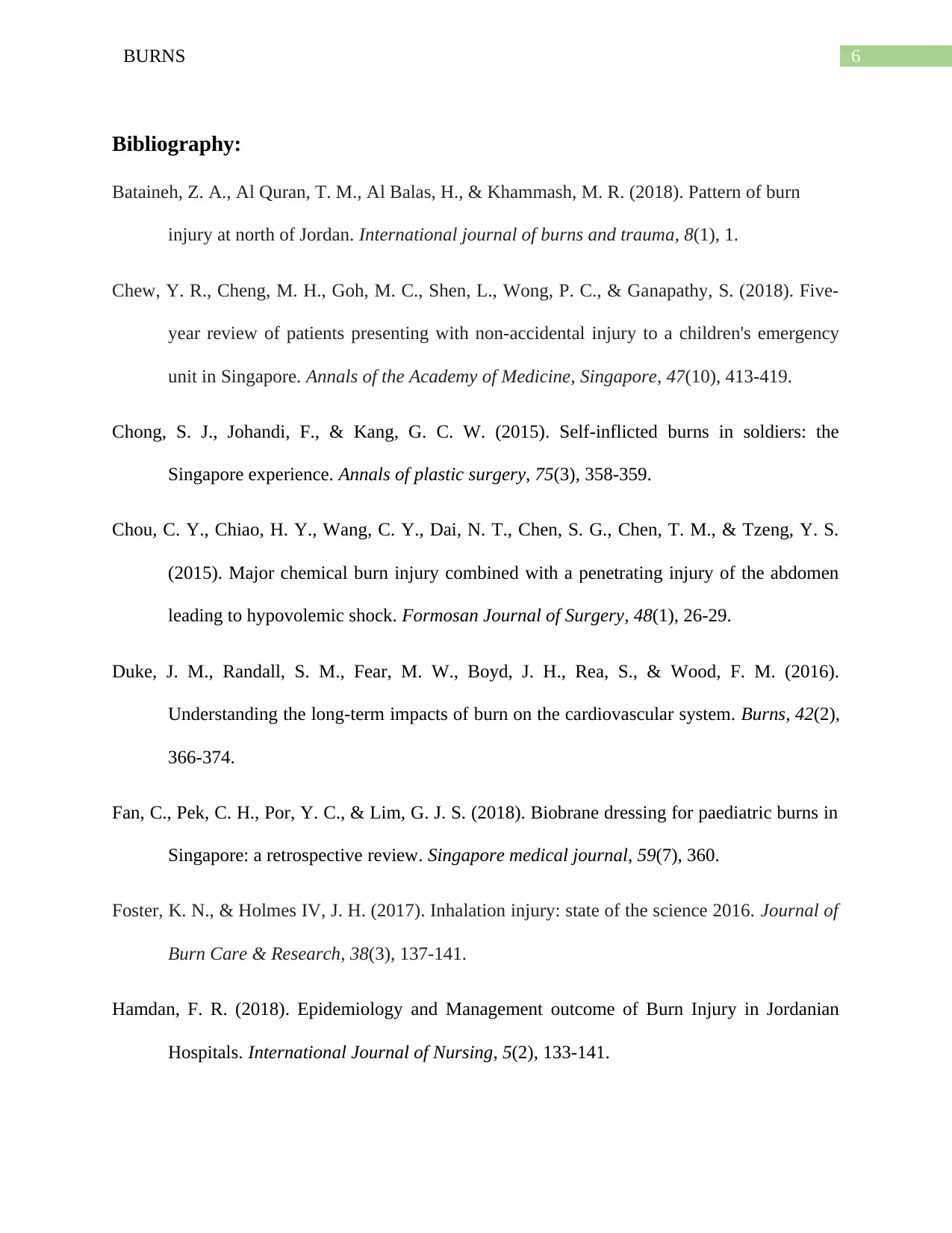
6BURNS
Bibliography:
Bataineh, Z. A., Al Quran, T. M., Al Balas, H., & Khammash, M. R. (2018). Pattern of burn
injury at north of Jordan. International journal of burns and trauma, 8(1), 1.
Chew, Y. R., Cheng, M. H., Goh, M. C., Shen, L., Wong, P. C., & Ganapathy, S. (2018). Five-
year review of patients presenting with non-accidental injury to a children's emergency
unit in Singapore. Annals of the Academy of Medicine, Singapore, 47(10), 413-419.
Chong, S. J., Johandi, F., & Kang, G. C. W. (2015). Self-inflicted burns in soldiers: the
Singapore experience. Annals of plastic surgery, 75(3), 358-359.
Chou, C. Y., Chiao, H. Y., Wang, C. Y., Dai, N. T., Chen, S. G., Chen, T. M., & Tzeng, Y. S.
(2015). Major chemical burn injury combined with a penetrating injury of the abdomen
leading to hypovolemic shock. Formosan Journal of Surgery, 48(1), 26-29.
Duke, J. M., Randall, S. M., Fear, M. W., Boyd, J. H., Rea, S., & Wood, F. M. (2016).
Understanding the long-term impacts of burn on the cardiovascular system. Burns, 42(2),
366-374.
Fan, C., Pek, C. H., Por, Y. C., & Lim, G. J. S. (2018). Biobrane dressing for paediatric burns in
Singapore: a retrospective review. Singapore medical journal, 59(7), 360.
Foster, K. N., & Holmes IV, J. H. (2017). Inhalation injury: state of the science 2016. Journal of
Burn Care & Research, 38(3), 137-141.
Hamdan, F. R. (2018). Epidemiology and Management outcome of Burn Injury in Jordanian
Hospitals. International Journal of Nursing, 5(2), 133-141.
Bibliography:
Bataineh, Z. A., Al Quran, T. M., Al Balas, H., & Khammash, M. R. (2018). Pattern of burn
injury at north of Jordan. International journal of burns and trauma, 8(1), 1.
Chew, Y. R., Cheng, M. H., Goh, M. C., Shen, L., Wong, P. C., & Ganapathy, S. (2018). Five-
year review of patients presenting with non-accidental injury to a children's emergency
unit in Singapore. Annals of the Academy of Medicine, Singapore, 47(10), 413-419.
Chong, S. J., Johandi, F., & Kang, G. C. W. (2015). Self-inflicted burns in soldiers: the
Singapore experience. Annals of plastic surgery, 75(3), 358-359.
Chou, C. Y., Chiao, H. Y., Wang, C. Y., Dai, N. T., Chen, S. G., Chen, T. M., & Tzeng, Y. S.
(2015). Major chemical burn injury combined with a penetrating injury of the abdomen
leading to hypovolemic shock. Formosan Journal of Surgery, 48(1), 26-29.
Duke, J. M., Randall, S. M., Fear, M. W., Boyd, J. H., Rea, S., & Wood, F. M. (2016).
Understanding the long-term impacts of burn on the cardiovascular system. Burns, 42(2),
366-374.
Fan, C., Pek, C. H., Por, Y. C., & Lim, G. J. S. (2018). Biobrane dressing for paediatric burns in
Singapore: a retrospective review. Singapore medical journal, 59(7), 360.
Foster, K. N., & Holmes IV, J. H. (2017). Inhalation injury: state of the science 2016. Journal of
Burn Care & Research, 38(3), 137-141.
Hamdan, F. R. (2018). Epidemiology and Management outcome of Burn Injury in Jordanian
Hospitals. International Journal of Nursing, 5(2), 133-141.
⊘ This is a preview!⊘
Do you want full access?
Subscribe today to unlock all pages.

Trusted by 1+ million students worldwide
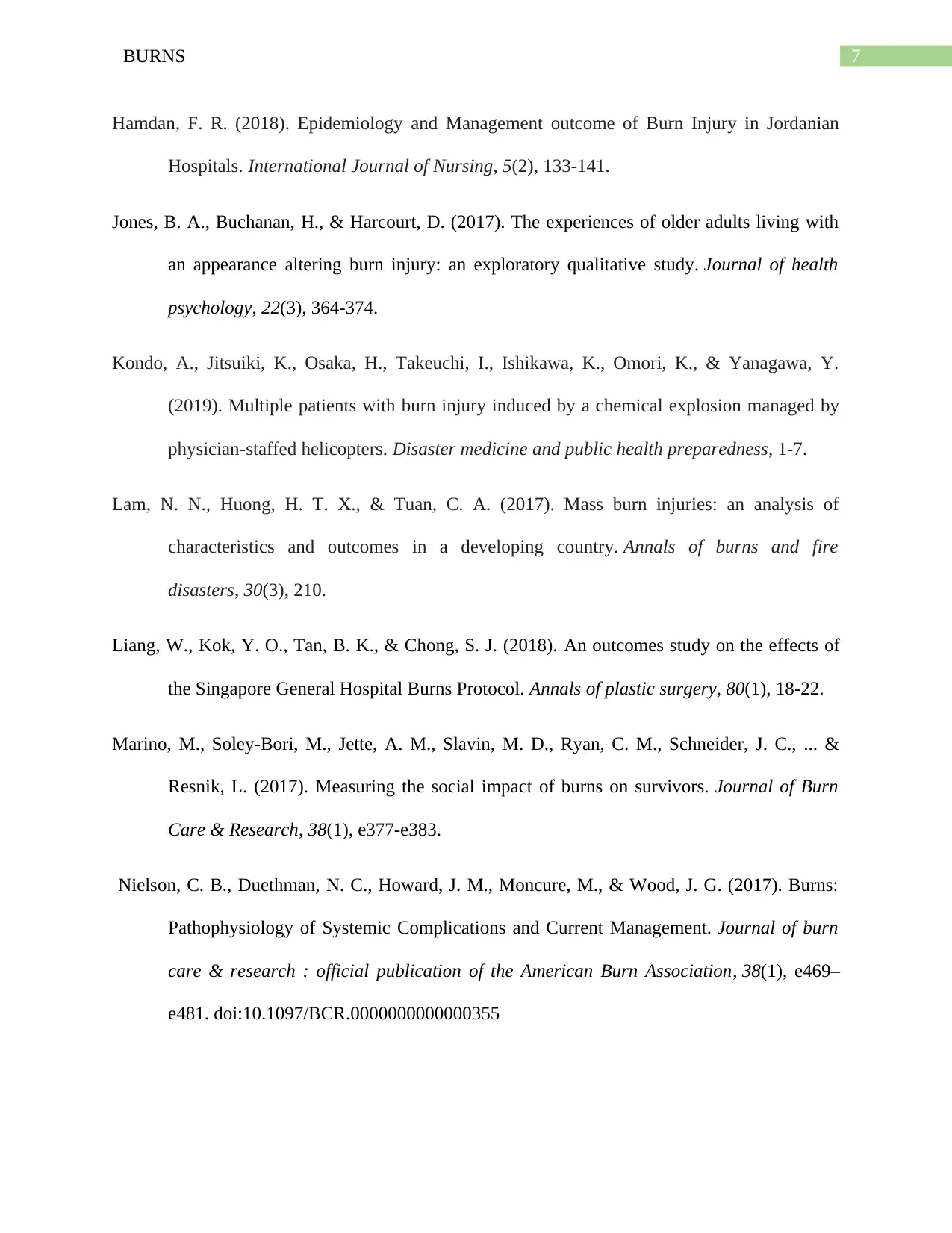
7BURNS
Hamdan, F. R. (2018). Epidemiology and Management outcome of Burn Injury in Jordanian
Hospitals. International Journal of Nursing, 5(2), 133-141.
Jones, B. A., Buchanan, H., & Harcourt, D. (2017). The experiences of older adults living with
an appearance altering burn injury: an exploratory qualitative study. Journal of health
psychology, 22(3), 364-374.
Kondo, A., Jitsuiki, K., Osaka, H., Takeuchi, I., Ishikawa, K., Omori, K., & Yanagawa, Y.
(2019). Multiple patients with burn injury induced by a chemical explosion managed by
physician-staffed helicopters. Disaster medicine and public health preparedness, 1-7.
Lam, N. N., Huong, H. T. X., & Tuan, C. A. (2017). Mass burn injuries: an analysis of
characteristics and outcomes in a developing country. Annals of burns and fire
disasters, 30(3), 210.
Liang, W., Kok, Y. O., Tan, B. K., & Chong, S. J. (2018). An outcomes study on the effects of
the Singapore General Hospital Burns Protocol. Annals of plastic surgery, 80(1), 18-22.
Marino, M., Soley-Bori, M., Jette, A. M., Slavin, M. D., Ryan, C. M., Schneider, J. C., ... &
Resnik, L. (2017). Measuring the social impact of burns on survivors. Journal of Burn
Care & Research, 38(1), e377-e383.
Nielson, C. B., Duethman, N. C., Howard, J. M., Moncure, M., & Wood, J. G. (2017). Burns:
Pathophysiology of Systemic Complications and Current Management. Journal of burn
care & research : official publication of the American Burn Association, 38(1), e469–
e481. doi:10.1097/BCR.0000000000000355
Hamdan, F. R. (2018). Epidemiology and Management outcome of Burn Injury in Jordanian
Hospitals. International Journal of Nursing, 5(2), 133-141.
Jones, B. A., Buchanan, H., & Harcourt, D. (2017). The experiences of older adults living with
an appearance altering burn injury: an exploratory qualitative study. Journal of health
psychology, 22(3), 364-374.
Kondo, A., Jitsuiki, K., Osaka, H., Takeuchi, I., Ishikawa, K., Omori, K., & Yanagawa, Y.
(2019). Multiple patients with burn injury induced by a chemical explosion managed by
physician-staffed helicopters. Disaster medicine and public health preparedness, 1-7.
Lam, N. N., Huong, H. T. X., & Tuan, C. A. (2017). Mass burn injuries: an analysis of
characteristics and outcomes in a developing country. Annals of burns and fire
disasters, 30(3), 210.
Liang, W., Kok, Y. O., Tan, B. K., & Chong, S. J. (2018). An outcomes study on the effects of
the Singapore General Hospital Burns Protocol. Annals of plastic surgery, 80(1), 18-22.
Marino, M., Soley-Bori, M., Jette, A. M., Slavin, M. D., Ryan, C. M., Schneider, J. C., ... &
Resnik, L. (2017). Measuring the social impact of burns on survivors. Journal of Burn
Care & Research, 38(1), e377-e383.
Nielson, C. B., Duethman, N. C., Howard, J. M., Moncure, M., & Wood, J. G. (2017). Burns:
Pathophysiology of Systemic Complications and Current Management. Journal of burn
care & research : official publication of the American Burn Association, 38(1), e469–
e481. doi:10.1097/BCR.0000000000000355
Paraphrase This Document
Need a fresh take? Get an instant paraphrase of this document with our AI Paraphraser
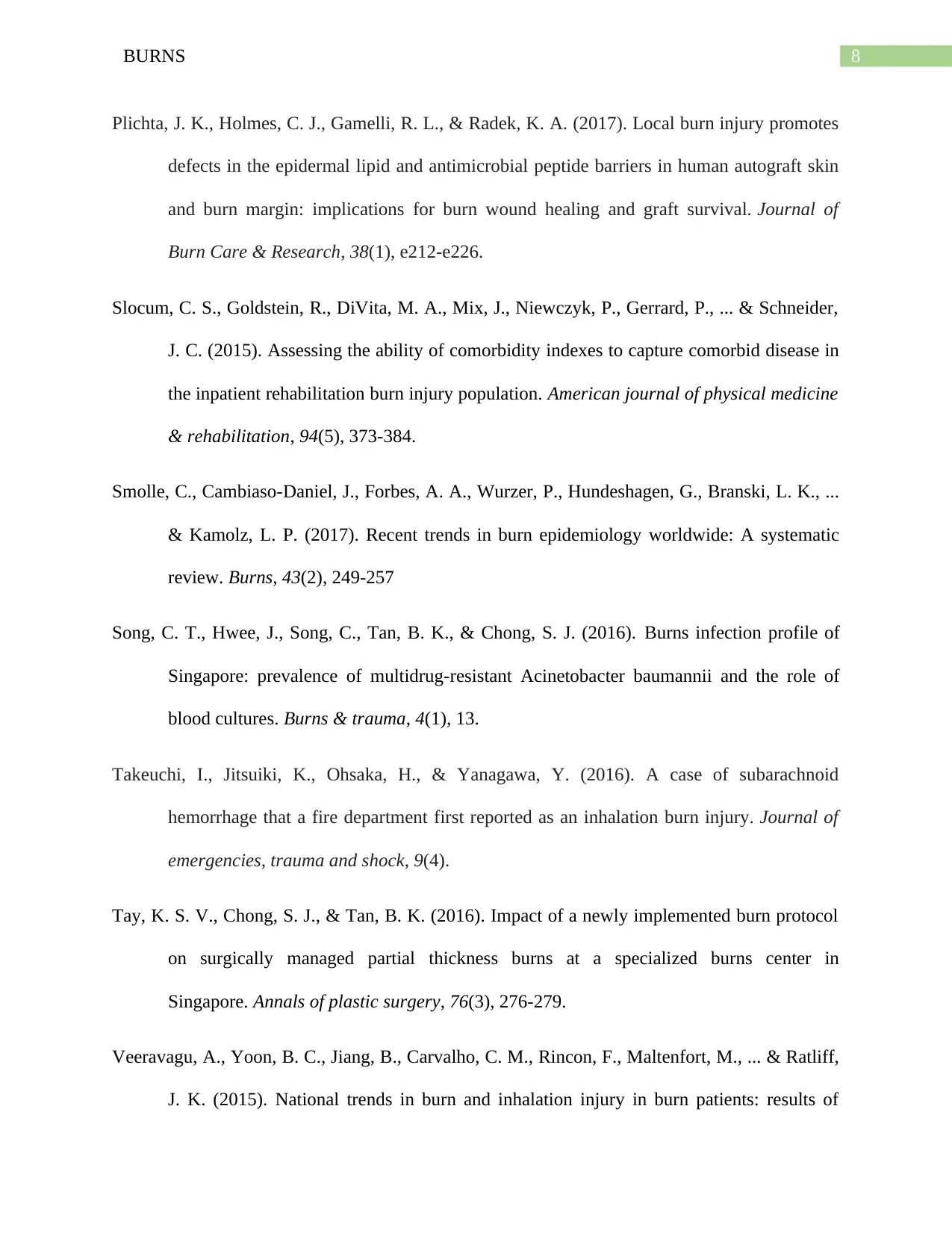
8BURNS
Plichta, J. K., Holmes, C. J., Gamelli, R. L., & Radek, K. A. (2017). Local burn injury promotes
defects in the epidermal lipid and antimicrobial peptide barriers in human autograft skin
and burn margin: implications for burn wound healing and graft survival. Journal of
Burn Care & Research, 38(1), e212-e226.
Slocum, C. S., Goldstein, R., DiVita, M. A., Mix, J., Niewczyk, P., Gerrard, P., ... & Schneider,
J. C. (2015). Assessing the ability of comorbidity indexes to capture comorbid disease in
the inpatient rehabilitation burn injury population. American journal of physical medicine
& rehabilitation, 94(5), 373-384.
Smolle, C., Cambiaso-Daniel, J., Forbes, A. A., Wurzer, P., Hundeshagen, G., Branski, L. K., ...
& Kamolz, L. P. (2017). Recent trends in burn epidemiology worldwide: A systematic
review. Burns, 43(2), 249-257
Song, C. T., Hwee, J., Song, C., Tan, B. K., & Chong, S. J. (2016). Burns infection profile of
Singapore: prevalence of multidrug-resistant Acinetobacter baumannii and the role of
blood cultures. Burns & trauma, 4(1), 13.
Takeuchi, I., Jitsuiki, K., Ohsaka, H., & Yanagawa, Y. (2016). A case of subarachnoid
hemorrhage that a fire department first reported as an inhalation burn injury. Journal of
emergencies, trauma and shock, 9(4).
Tay, K. S. V., Chong, S. J., & Tan, B. K. (2016). Impact of a newly implemented burn protocol
on surgically managed partial thickness burns at a specialized burns center in
Singapore. Annals of plastic surgery, 76(3), 276-279.
Veeravagu, A., Yoon, B. C., Jiang, B., Carvalho, C. M., Rincon, F., Maltenfort, M., ... & Ratliff,
J. K. (2015). National trends in burn and inhalation injury in burn patients: results of
Plichta, J. K., Holmes, C. J., Gamelli, R. L., & Radek, K. A. (2017). Local burn injury promotes
defects in the epidermal lipid and antimicrobial peptide barriers in human autograft skin
and burn margin: implications for burn wound healing and graft survival. Journal of
Burn Care & Research, 38(1), e212-e226.
Slocum, C. S., Goldstein, R., DiVita, M. A., Mix, J., Niewczyk, P., Gerrard, P., ... & Schneider,
J. C. (2015). Assessing the ability of comorbidity indexes to capture comorbid disease in
the inpatient rehabilitation burn injury population. American journal of physical medicine
& rehabilitation, 94(5), 373-384.
Smolle, C., Cambiaso-Daniel, J., Forbes, A. A., Wurzer, P., Hundeshagen, G., Branski, L. K., ...
& Kamolz, L. P. (2017). Recent trends in burn epidemiology worldwide: A systematic
review. Burns, 43(2), 249-257
Song, C. T., Hwee, J., Song, C., Tan, B. K., & Chong, S. J. (2016). Burns infection profile of
Singapore: prevalence of multidrug-resistant Acinetobacter baumannii and the role of
blood cultures. Burns & trauma, 4(1), 13.
Takeuchi, I., Jitsuiki, K., Ohsaka, H., & Yanagawa, Y. (2016). A case of subarachnoid
hemorrhage that a fire department first reported as an inhalation burn injury. Journal of
emergencies, trauma and shock, 9(4).
Tay, K. S. V., Chong, S. J., & Tan, B. K. (2016). Impact of a newly implemented burn protocol
on surgically managed partial thickness burns at a specialized burns center in
Singapore. Annals of plastic surgery, 76(3), 276-279.
Veeravagu, A., Yoon, B. C., Jiang, B., Carvalho, C. M., Rincon, F., Maltenfort, M., ... & Ratliff,
J. K. (2015). National trends in burn and inhalation injury in burn patients: results of
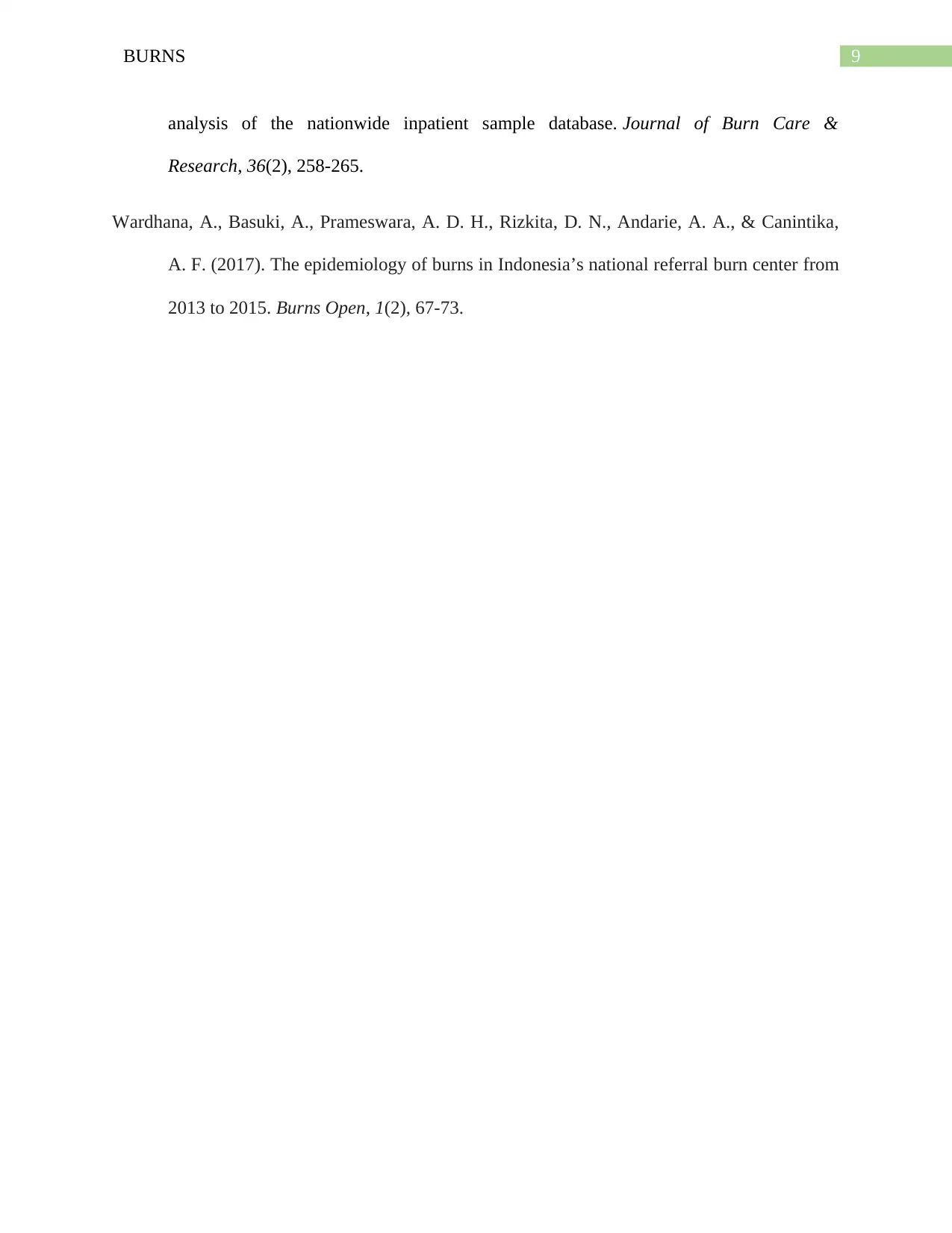
9BURNS
analysis of the nationwide inpatient sample database. Journal of Burn Care &
Research, 36(2), 258-265.
Wardhana, A., Basuki, A., Prameswara, A. D. H., Rizkita, D. N., Andarie, A. A., & Canintika,
A. F. (2017). The epidemiology of burns in Indonesia’s national referral burn center from
2013 to 2015. Burns Open, 1(2), 67-73.
analysis of the nationwide inpatient sample database. Journal of Burn Care &
Research, 36(2), 258-265.
Wardhana, A., Basuki, A., Prameswara, A. D. H., Rizkita, D. N., Andarie, A. A., & Canintika,
A. F. (2017). The epidemiology of burns in Indonesia’s national referral burn center from
2013 to 2015. Burns Open, 1(2), 67-73.
⊘ This is a preview!⊘
Do you want full access?
Subscribe today to unlock all pages.

Trusted by 1+ million students worldwide
1 out of 9
Related Documents
Your All-in-One AI-Powered Toolkit for Academic Success.
+13062052269
info@desklib.com
Available 24*7 on WhatsApp / Email
![[object Object]](/_next/static/media/star-bottom.7253800d.svg)
Unlock your academic potential
Copyright © 2020–2025 A2Z Services. All Rights Reserved. Developed and managed by ZUCOL.





